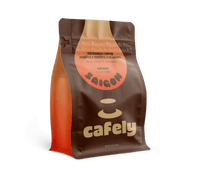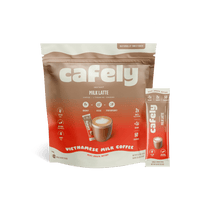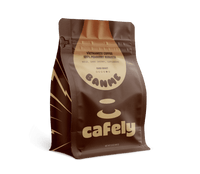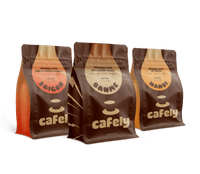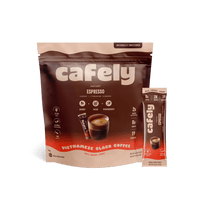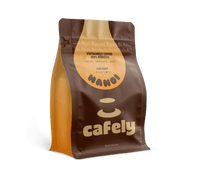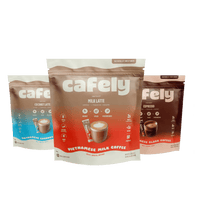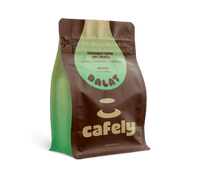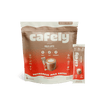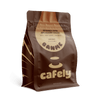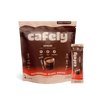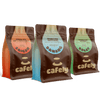Espresso is an Italian brew made with arabica coffee.
Loosely translated, espresso means “pressed out” — referring to the way it's brewed. Finely ground arabica coffee is packed into a portafilter and locked into an espresso machine, where pressurized hot water is forced through the grounds to extract a rich, dark shot of coffee with a fine crema.
The espresso is the world’s favorite coffee. Although it’s not enjoyed in its raw form by the masses, it’s the base for a range of popular brews such as the latte, Americano coffee, flat white, and mocha coffee.
Read on to learn more about espresso coffee, its origins, the brews it has birthed, and how to make it…
What is Espresso Coffee & What Makes it Unique?

Espresso coffee is a concentrated coffee that’s brewed by forcing hot water under high pressure through finely ground arabica coffee beans. The brew was invented in Italy sometime during the early 1900s, although it has evolved over the years.
It's typically served in small, 30 mL (1 oz.) shots in demitasse cups. It's known for its intense but smooth flavor, rich, velvety texture, and creamy, caramel-like crema.
Unlike drip coffee which uses a slower, gravity-based means of brewing, espresso is produced in under 30 seconds by using a specialized machine.
Espresso is the base for a range of coffee beverages that are commonplace in cafes, coffee houses, and restaurants.
Espresso-based beverages include:
- Americano
- Latte
- Cappuccino
- Flat White
- Macchiato
- Mocha
- Cortado
- Ristretto
- Lungo
- Affogato
What Does Espresso Coffee Taste Like?
The espresso has a distinct taste that varies slightly depending on the beans, roast level, and extraction time used. However, some general flavor characteristics define a high-quality shot:
- Rich and intense — Espresso has a strong, bold flavor with a rich mouthfeel. It’s much more intense and concentrated than drip or French press coffee due to its concentration of coffee oils and solids.
- Balanced bitterness — Surprisingly, a well-pulled shot of espresso isn’t overly bitter. The brew balances the natural bitter, sweet, and acidic notes of arabica coffee. When brewed correctly, it features a pleasant acidity with notes of fruit and citrus without overwhelming bitterness.
- Notes of chocolate, nuts, and fruit — When espresso is brewed with fresh, high-quality arabica beans, the subtler notes of the beans shine through. You’ll pick out complex notes of chocolate, caramel, nuts, citrus, and caramel, depending on the origin of the beans used to brew the shot.
- Creamy and velvety texture — The body of espresso can be described as thick. Fine coffee particles suspended in the brew provide a smooth and creamy mouthfeel. The caramel-like crema (foam on top of the coffee) also produces a velvety and smooth mouthfeel.
The espresso is unique for its concentrated, intense flavor. Its creamy, layered taste and potent caffeine hit (around 75 mg per 30 mL of coffee) make it a favorite among coffee enthusiasts.
The complex yet intense flavor profile of espresso also makes it a staple in many coffee-based drinks (as mentioned above). Its rich flavor and high caffeine content allow the beans to shine through large amounts of cold or steamed milk.
How to Make Espresso Coffee: Step-by-Step
Espresso coffee is easy to make, provided you have the right equipment and high-quality whole arabica beans.
Here’s what you need to make espresso:
Ingredients:
- High-quality arabica coffee beans — If you want to produce a rich, complex espresso with the perfect crema, high-quality arabica beans are vital.
- Filtered water — Using pure filtered water ensures the best possible flavor extraction.
Equipment:
- Burr coffee grinder — A burr grinder will produce a fine grind similar to powdered sugar. The burr grinder’s ability to produce a consistent grind is essential for even extraction.
- Espresso machine — You can’t make a true espresso without an espresso machine. Machines vary in size, shape, and cost.
- Tamper — This small press allows you to tamp the grounds evenly into the espresso machine’s portafilter. This simple piece of equipment will help you produce a perfectly extracted espresso shot.
- Demitasse cup — A small cup that can accommodate 60 to 90 mL of coffee (ideal for espresso).
1. Prepare the Espresso Machine
First, heat your espresso machine. Depending on the machine you own, this could take up to 30 minutes, so be sure to do this in plenty of time.
Fill the water reservoir with clean, fresh, filtered water. Avoid using water directly from the tap — minerals in hard water can taint the taste of the coffee and cause damage to your machine over time.
2. Measure and Grind the Coffee
Next, weigh out your coffee. You’ll need around nine grams for a single shot of espresso and 18 grams for a double shot. We recommend a high-quality arabica coffee such as Cafely DaLat for making espresso.
Once you’ve weighed out the coffee, grind the beans to a fine consistency (similar to powdered sugar) using a burr grinder.
3. Fill the Portafilter
Add the ground coffee to the portafilter and tamp the grounds down with the tamper. Make sure to apply firm, even pressure, to create a smooth "puck" of coffee. This will encourage more even extraction.
4. Brew the Espresso
Lock the portafilter into the group head of your espresso machine and begin brewing. Time the extraction — you should aim for a 25 to 30-second extraction for a regular espresso. Pull the shot for 15 to 20 seconds to create a more concentrated shot (ristretto).
During brewing, you should see a fine, smooth, uninterrupted stream of caramel-colored coffee pouring into your demitasse cup.
5. Assess the Espresso Shot
Observe your espresso shot. You should have produced a dark shot of coffee with a rich, velvety, caramel-colored crema on top.
The shot should taste rich, smooth, and strong but not overly bitter or sour.
Troubleshooting: My Espresso Shot Doesn’t Taste Right

If your espresso shot isn't tasting as good as one you'd order from a barista; there are a few things you can check.
Here’s why your espresso may not taste quite right and how to resolve the issues:
1. Check Your Beans
If your shot doesn’t taste up to par, the first thing to check is your beans. Make sure your coffee beans are fresh — roasted less than one month ago.
Grind a pinch to a coarse consistency and evaluate the grounds. They should smell fragrant with distinct floral, nutty, and/or woody notes. They should look slightly oily — not dry and powdery. If the grounds smell dull, musky, or sour, your coffee beans have gone bad.
To resolve this, purchase a new bag of fresh arabica beans.
2. Check Your Portafilter for Channeling
The next thing to check is how you pack the portafilter. Uneven extraction (channeling) can occur if you don’t pack the grounds evenly into the portafilter. If your shot tastes underwhelming — weak and watery or sour, this is likely the cause.
After brewing, assess the grounds in the portafilter. If it looks like the water has made a “channel” around or through the coffee puck, the shot wasn’t extracted properly. The coffee should be evenly damp — showing an even extraction throughout the grounds has occurred.
To resolve this, make sure there are no “weak spots” when packing your portafilter.
Take extra care when packing the portafilter, ensuring you distribute the coffee grounds evenly before tamping and apply firm, even pressure during tamping.
3. Under Extraction
If your espresso shot tastes sour and your beans are fresh, it has likely been under-extracted. Under extraction produces a sour shot because the water hasn’t had time to dissolve the full flavors of the beans.
There are a few reasons under extraction may have occurred:
- The grind is too coarse — The grind size should be similar to powdered sugar. A grind that’s too coarse will produce an under-extracted espresso. To resolve this, make sure to grind the coffee properly before filling the portafilter.
- The brew time is too short — If the grind size is correct and your shot still tastes sour, you may not be brewing the espresso for long enough. To resolve this, increase the brew time by five to 10 seconds. The ideal brewing time for espresso is 25 to 30 seconds but this can vary depending on the machine.
- Uneven tamping — As mentioned above, your shot may taste sour because of channeling. If your grind size and brew time are correct, make sure the grounds are dispersed and tamped evenly.
4. Over Extraction
If your espresso tastes overly bitter, it has been over-extracted. When arabica beans are exposed to hot water for too long, the water will extract the more bitter, unpleasant compounds from the coffee.
There are a few reasons over-extraction may have occurred:
- The grind is too fine — Over-extraction can occur from coffee that’s ground too fine. To resolve this, opt for a slightly coarser grind size.
- The brew time is too long — If the grind size is correct, you may be over-brewing the shot. To resolve this, shorten the brewing time by five to 10 seconds. The ideal brewing time can vary from machine to machine.
- Over-tamping — Over-extraction can occur if the grounds are packed too tightly in the portafilter. It takes longer for water to penetrate tightly-packed grounds. To resolve this, lessen the pressure used during tamping.
The History of Espresso Coffee
The history of espresso can be traced back surprisingly far. Although it's easy to assume that espresso is a recent invention, due to the advanced espresso machines we use today, the beverage can be traced back to the 1800s.
Here’s a brief history of the espresso coffee:
1. The First Espresso Machine (1884)
The first espresso machine was invented in 1884 by Angelo Moriondo in Turin, Italy. It was ingeniously named “New steam machinery for the economic and instantaneous confection of coffee beverage, method 'A. Moriondo” (translation to English).
This machine was a bulk brewer that used steam to brew a large amount of concentrated coffee to speed up order fulfillment in cafes. The brew created from these early machines was nothing like a modern "espresso" — it tasted more burnt and bitter, likely due to over-extraction.
2. The “New and Improved” Espresso Machine (1901)
In 1901, a young man from Milano by the name of Luigi Bezzera patented a new and improved espresso machine that worked on a similar premise to Angelo Moriondo’s machine. However, Bezzera’s espresso machine has a single boiler and four group heads for creating single servings of concentrated coffee.
This machine still worked by forcing steam through finely ground coffee, so the brews were often over-extracted.
3. The First Commercial Espresso Machines (1905)
Desiderio Pavoni purchased Luigi Bezzera’s patent in 1903 and formed the “La Pavoni” company in 1905.
He started to manufacture steam-powered espresso machines throughout the early 20th century and made them commercially available to cafes and coffee houses in Italy. Pavoni also coined the term “espresso” to describe the fast, on-demand nature of the brew and its “pressed” brewing method.
4. The Early Adoption of Espresso (1920s)
By the 1920s, the La Pavoni company grew internationally. Desiderio Pavoni’s steam-powered espresso machines were being sold across Europe.
The first espresso machine was installed in the United States in 1927, at "Reggios" in New York. This marked the beginning of a worldwide obsession with espresso.
5. The First Piston Pump Espresso Machines (1938 Onward)
Although the steam-powered espresso machine was gaining popularity, the quality of the brews left much to be desired. The brewing equipment required an upgrade to improve the flavor qualities of the coffee.
Antonio Cremonese invented the first piston-pump espresso machine in 1938. This new machine worked with the same group head system as Pavoni’s machines but forced hot (not boiling) water through the finely ground coffee instead of steam.
These machines revolutionized this type of coffee. It eliminated the over-extraction issues and created a brew with a more natural, fuller flavor and a velvety crema, which has become a major desirable characteristic of espresso coffee today.
6. Espresso as we know it is Born (1946)
The development of Cremonese’s piston pump coffee machines stalled during World War Two. However, in 1946, Achille Gaggia began to commercially produce the machines.
These machines used a spring-powered lever to create significantly higher pressure (9 bars), producing the rich, concentrated espresso shot we recognize today.
7. The Global Expansion of Espresso Coffee (1950–Present)
By the 1950s, espresso culture had spread across the globe. Italian immigrants introduced the espresso as we know it today to several parts of Europe and the Americas.
As espresso machines became more available, they became more common in cafes and coffee houses across the globe.
Today, espresso is everywhere. It’s the base of a range of coffee beverages and a staple in cafes, coffee houses, restaurants, and fast-food chains in America, Europe, Asia, and Africa.
What Coffee is Made From Espresso?

Several popular coffees are made from espresso. This concentrated shot of arabica coffee is the base for a range of drinks from the humble Americano to the elegant cappuccino.
Here are five popular espresso-based beverages:
1. Americano
The Americano is a black, thin-bodied coffee that's created by diluting espresso with hot water. The Americano is similar in flavor and body to drip coffee, but it retains the rich, smooth espresso flavor.
This drink is smooth, light, and much less intense than straight espresso.
2. Cafe Latte
The cafe latte (latte coffee) is a creamy, mild drink made with a shot of espresso and a generous amount of steamed milk. It’s topped with a small layer of microfoam milk.
This beverage has a smooth, balanced flavor and a light, velvety texture.
3. Flat White
The flat white is similar to a latte. It originates from Australia or New Zealand (debated). It consists of a shot of espresso and a moderate amount of velvety, micro-foamed milk. It has a higher ratio of espresso to milk than a latte.
This brew is bold, silky, and smooth but holds a stronger espresso flavor than a latte.
4. Macchiato
The macchiato (meaning marked in Italian) is an espresso shot that’s topped with a small amount of steamed milk. Only the microfoam from a milk pitcher is used — creating a dark, rich shot of coffee with a velvety foam on top.
This beverage provides all the intensity of a regular shot of espresso with a touch of creaminess that cuts through some of the bitterness of the brew.
5. Cappuccino
The cappuccino is a classic Italian beverage that combines equal parts espresso, steamed milk, and microfoam. It's known for its rich, airy texture and balanced, bold, yet creamy flavor profile. Choosing the best coffee for cappuccino can elevate the flavor even more — look for medium to dark roast beans with nutty or chocolatey notes to balance the milk.
6. Mocha
The mocha coffee is a blend of espresso, steamed milk, and chocolate syrup. It’s often topped with a dollop of whipped cream and a dusting of cocoa powder.
The mocha combines the bitterness of espresso with the sweetness of chocolate, creating a creamy dessert-like beverage for coffee and chocolate lovers.
FAQs: What is Espresso Coffee?
Do you have any more questions about espresso and other types of coffee?
You may find the answers you're looking for in the FAQs below…
1. How Much Caffeine in a Shot of Espresso?
A regular shot of espresso brewed with dark roast arabica coffee contains around 75 mg of caffeine. A double shot of espresso contains double the amount of caffeine — roughly 140 mg.
2. Is Moka Pot Coffee the Same as Espresso?
Moka pot coffee is similar to espresso. The moka pot is a stovetop brewer that forces pressurized hot water through finely ground coffee. It creates a concentrated brew with a rich, creamy crema — similar to an espresso.
3. Can You Make Espresso Without a Machine?

You can’t make a true espresso without an espresso machine. However, you can make a similar brew with a moka pot or an Aeropress. You can also make a concentrated espresso-like brew fast with an instant espresso blend such as Cafely’s Instant Vietnamese Espresso 2.0 — perfect for those looking for a quick and convenient method for making instant espresso without sacrificing bold flavor.
4. What is a Latte?
A latte is an espresso-based beverage that’s made with a single or double shot of espresso and a large amount of steamed milk. It has a thick, velvety texture and a rich, creamy taste.
5. What is a Flat White?
The flat white is similar to the latte. It was invented in Australia or New Zealand (debated) and uses espresso and steamed milk. It typically contains a more concentrated shot of espresso and less steamed milk than a latte, creating a richer coffee with a more foamy texture.
6. What is Mocha Coffee?
Mocha coffee combines coffee and chocolate. It’s made with espresso, steamed milk, and dark chocolate or cocoa powder. It’s a sweet, indulgent beverage that’s perfect for both coffee and chocolate lovers alike.
7. What’s the Difference Between Espresso and Ristretto?
Espresso and ristretto are both made using an espresso machine. The difference comes in the coffee-to-water ratio used. Ristretto is made using the same amount of coffee as an espresso shot but less water, creating a stronger, more concentrated shot of coffee.
8. Does Espresso Have any Calories?
Yes. Espresso does contain calories but only an incredibly small amount. A single shot of espresso contains around one to two calories.
9. Can You Make Iced Coffee with Espresso?
Yes. Espresso is perfect for making delicious iced coffee. To make an iced coffee with espresso, simply brew a single or double shot, allow to cool, and pour over ice with milk and sugar.
10. How Long Does Espresso Coffee Last?
Once brewed, espresso is best consumed immediately. However, if you wish to save it for making iced coffee, espresso can be stored in the fridge for 24 to 48 hours. Do this before it goes bad.
